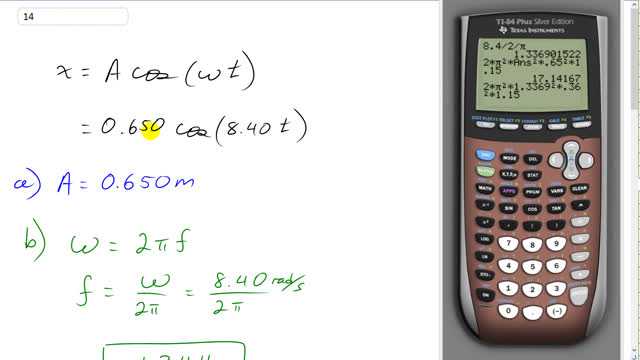
A 1.15-kg mass oscillates according to the equation where is in meters and in seconds. Determine
- the amplitude,
- the frequency,
- the total energy, and
- the kinetic energy and potential energy when x = 0.360 m.

In order to watch this solution you need to have a subscription.
This is Giancoli Answers with Mr. Dychko. We know that position of a harmonic oscillator is amplitude times cosine times the angular velocity times time. And we compare that with the formula we're given 0.650 times cosine of 8.4 t and we compare corresponding parts here. So, we have this factor in front of the trig function is amplitude. So, the amplitude is 0.650 meters. And then for Barbie and we can figure out the frequency by knowing that the angular velocity is 2π times frequency 2π radians times the number of cycles per second 2π radians per cycle times cycles per second gives you radians per second. And anyway, we divide this by 2π on both sides and you get frequency as angular velocity divided by 2π. So, that's 8.40 radians per second divided by 2π. And we know that 8.4 because compare the inside parts here. The factor multiplied by t is the angular velocity. So, ω is 8.4. This works out to 1.34 hertz. And then finding the total energy we know is 1/2 times spring constant times amplitude squared. And frequency is 1 over 2π times square root k over m. And we're going to solve for k using this formula. So, we'll multiply both sides by 2π first and then we'll square both sides and then multiply it by m. And we get spring constant is 4π squared f squared times m and we substitute that in for k. And we get total energy is 1/2 times 4π squared f squared times mass times amplitude squared. And the 1/2 times 4 makes 2 2π squared f squared A squared times m. And then we have 2π squared times 1.3369 hertz squared and then multiplied by the amplitude, 0.56 meters, squared times by the mass, 1.15 kilograms. And that gives 17.1 joules of total energy the potential energy at any point is 1/2 k times that position squared. And we just found out before that k is 4π squared f squared m. So, we plug that in and then this works out to 2π squared f squared x squared times m and that's 2π squared times the frequency squared times this position here of 0.36 meters squared times the mass and that works out too. 5.26 six joules. That's the potential energy at this point and the kinetic energy with the total energy minus the potential energy and so that's 17.1417 minus this 5.2581 joules using lots of digits here because we want to avoid intermediate rounding error. So, we'll take 17.1417 minus the answer in the previous line. And we get kinetic energy must be about 11.9 joules.
Hi Professor Ditchko,
For part c, (solving for the total energy), I set the force of gravity equal to the spring force (with x = 0.36 m) and solved for k (31.3 N m). I then used the total energy equation 1/2(K A^2) and came up with 6.6 J. Why is this wrong? Can I not use the given x=0.36 as the equilibrium position here?
Thanks so much!
I apologize but I made a mistake with my original question. I multiplied 1/2 K value (31.3 N m) by the amplitude squared (.65), not by the equilibrium value x=.36 m.
Sorry about that!